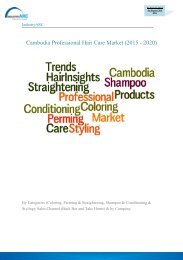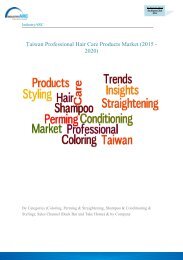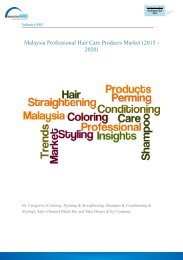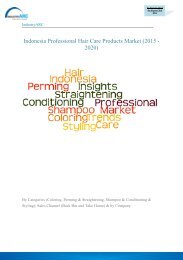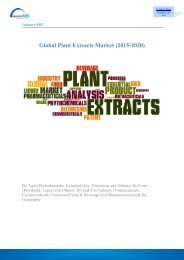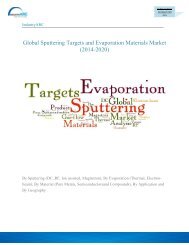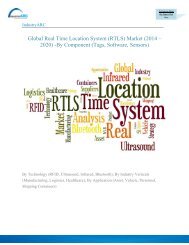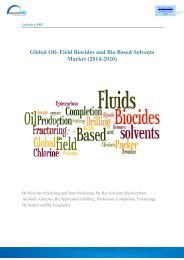Global Fiber Intermediates Market (2014–2020)
Fiber Intermediates refer to the products which are used in the production of fabrics, plastics, disinfectants and these applications can be used as a raw material by various industries such as textile, automobile, petrochemical, plastics industries and others. In this report , global fiber intermediate market is segmented based on type, application, geography. The global fiber intermediates market is evaluated based on key attributes such as ethylene glycol (eg), polyethylene, acrylonitrile, , orthoxylene, toluene, paraxylene and others. Also, end users of fiber intermediates are polyester, nylon, Spandex fibers, Anti-freezers, polyurethane resins, bactericides.
Fiber Intermediates refer to the products which are used in the production of fabrics, plastics, disinfectants and these applications can be used as a raw material by various industries such as textile, automobile, petrochemical, plastics industries and others. In this report , global fiber intermediate market is segmented based on type, application, geography. The global fiber intermediates market is evaluated based on key attributes such as ethylene glycol (eg), polyethylene, acrylonitrile, , orthoxylene, toluene, paraxylene and others. Also, end users of fiber intermediates are polyester, nylon, Spandex fibers, Anti-freezers, polyurethane resins, bactericides.
Create successful ePaper yourself
Turn your PDF publications into a flip-book with our unique Google optimized e-Paper software.
To Enquire About<br />
the Report Click<br />
Here<br />
IndustryARC<br />
<strong>Global</strong> <strong>Fiber</strong> <strong>Intermediates</strong> <strong>Market</strong> (<strong>2014–2020</strong>)<br />
By Type (Paraxylene, Orthoxylene, TPA, Caprolactum, Toluene, polyethylene and<br />
Others); By Application (Polyester, Nylon, bactericides, Spandex fibers, Antifreezers<br />
and others ) and By Geography
To Enquire About<br />
the Report Click<br />
Here<br />
TABLE OF CONTENTS<br />
1. <strong>Global</strong> <strong>Fiber</strong> <strong>Intermediates</strong> – <strong>Market</strong> Overview<br />
2. Executive Summary<br />
3. <strong>Global</strong> <strong>Fiber</strong> <strong>Intermediates</strong> – <strong>Market</strong> Landscape<br />
3.1. <strong>Market</strong> Share Analysis<br />
3.2. Comparative Analysis<br />
3.2.1. Product Benchmarking<br />
3.2.2. End User Profiling<br />
3.2.3. Top 5 Financials Analysis<br />
4. <strong>Global</strong> <strong>Fiber</strong> <strong>Intermediates</strong> – <strong>Market</strong> Forces<br />
4.1. <strong>Market</strong> Drivers<br />
4.2. <strong>Market</strong> Constraints<br />
4.3. <strong>Market</strong> Challenges<br />
4.4. Attractiveness of the <strong>Global</strong> <strong>Fiber</strong> <strong>Intermediates</strong> Industry<br />
4.4.1. Power Of Suppliers<br />
4.4.2. Power Of Customers<br />
4.4.3. Threat Of New Entrants<br />
4.4.4. Threat Of Substitution<br />
4.4.5. Degree Of Competition<br />
5. <strong>Global</strong> <strong>Fiber</strong> <strong>Intermediates</strong> – Strategic Analysis<br />
5.1. Value Chain Analysis<br />
5.2. Pricing Analysis<br />
5.3. Opportunities Analysis<br />
5.4. Product/<strong>Market</strong> Life Cycle Analysis
To Enquire About<br />
the Report Click<br />
Here<br />
5.5. Suppliers And Distributors<br />
6. <strong>Global</strong> <strong>Fiber</strong> <strong>Intermediates</strong> – By Type<br />
6.1. Paraxylene<br />
6.2. Caprolactum<br />
6.3. Orthoxylene<br />
6.4. Acrylonitrile<br />
6.5. Toluene<br />
6.6. Polyethylene<br />
6.7. Ethylene Glycol (EG)<br />
6.7.1. Monoethylene Glycol<br />
6.7.2. Diethylene Glycol<br />
6.8. OTHERS<br />
6.8.1. Polyethylene Terephthalate (PET)<br />
6.8.2. Dimethyl Terephthalyte (DMT)<br />
6.8.3. Polyacrylonitrile<br />
7. <strong>Global</strong> <strong>Fiber</strong> <strong>Intermediates</strong> – By Application<br />
7.1. Fabrics<br />
7.1.1 Polyster<br />
7.1.2 Nylon<br />
7.1.3 Spandex fibers<br />
7.2. Antifreezes<br />
7.3. Detergents<br />
7.4. Paints<br />
7.5. Polyurethane Resins<br />
7.6. Bactericides
To Enquire About<br />
the Report Click<br />
Here<br />
7.6.1. Disinfectants<br />
7.6.2. Antiseptics<br />
7.6.3. Antibiotics<br />
7.7. Others<br />
7.7.1. Bottles<br />
7.7.2. Non-Food Packaging<br />
7.7.3. Cards (Plastic, Paper)<br />
7.7.4. Inflatable Products<br />
7.7.5. Pipe<br />
8. <strong>Global</strong> <strong>Fiber</strong> <strong>Intermediates</strong> <strong>Market</strong>—By Geography<br />
8.1. Introduction<br />
8.2. Americas<br />
8.2.1. North America<br />
8.2.2. Brazil<br />
8.2.3. Argentina<br />
8.2.4. Mexico<br />
8.3. Europe<br />
8.3.1. UK<br />
8.3.2. France<br />
8.3.3. Germany<br />
8.4. APAC<br />
8.4.1. China<br />
8.4.2. South Korea<br />
8.4.3. Japan<br />
8.4.4. Australia
To Enquire About<br />
the Report Click<br />
Here<br />
8.5. Row<br />
9. <strong>Market</strong> Entropy<br />
9.1. New product launches<br />
9.2. M&A’s, collaborations, JVs and partnerships<br />
10. Company Profiles<br />
10.1. Koninklijke DSM N.V.<br />
10.2. Invista<br />
10.3. <strong>Fiber</strong> Intermediate Products Company(FIPCO)<br />
10.4. Reliance Industries Limited<br />
10.5. BASF SE<br />
10.6. DOW Chemical company<br />
10.7. Indian petrochemical corporation limited<br />
10.8. Diacel chemical industries Ltd<br />
10.9. Nylacast Limited Company<br />
10.10. SunAllomer Ltd.<br />
10.11. Sumitomo Chemical Co. Ltd.<br />
10.12. Mitsubishi Engineering-Plastics Corporation<br />
10.13. Ube Industries, Ltd..<br />
10.14. Haldia Petrochemicals Limited<br />
10.15. Saudi Basic Industries Corporation (SABIC)<br />
10.16. Niagara <strong>Fiber</strong> Intermediate Corp.<br />
10.17. Toray Industries, Inc.<br />
10.18. ITOCHU Corporation.<br />
10.19. Caprolactum Chemical Ltd.<br />
10.20. ME<strong>Global</strong> Solutions
To Enquire About<br />
the Report Click<br />
Here<br />
11. Appendix<br />
11.1. Abbreviations<br />
11.2. Sources<br />
11.3. Research methodology<br />
11.4. Bibliography<br />
11.5. Compilation of expert insights<br />
11.6. Disclaimer
To Enquire About<br />
the Report Click<br />
Here<br />
LIST OF TABLES<br />
Table 1 <strong>Global</strong> <strong>Fiber</strong> <strong>Intermediates</strong> <strong>Market</strong> – Pricing Analysis ($)<br />
Table 2 <strong>Global</strong> <strong>Fiber</strong> <strong>Intermediates</strong> <strong>Market</strong> Revenue, By Type, 2014-2020 ($M)<br />
Table 3 <strong>Global</strong> <strong>Fiber</strong> <strong>Intermediates</strong> <strong>Market</strong> Volume, By Type, 2014-2020 (Kilo Tons)<br />
Table 4 <strong>Global</strong> <strong>Fiber</strong> <strong>Intermediates</strong> <strong>Market</strong> Revenue, By Application, 2014-2020 ($M)<br />
Table 5 <strong>Global</strong> <strong>Fiber</strong> <strong>Intermediates</strong> <strong>Market</strong> Volume, By Application, 2014-2020 (Kilo Tons)<br />
Table 6 <strong>Global</strong> <strong>Fiber</strong> <strong>Intermediates</strong> <strong>Market</strong> Revenue, By Geography, 2014-2020 ($M)<br />
Table 7 <strong>Global</strong> <strong>Fiber</strong> <strong>Intermediates</strong> <strong>Market</strong> Volume, By Geography, 2014-2020 (Kilo Tons)<br />
Table 8 <strong>Global</strong> Paraxylene <strong>Market</strong> Revenue, By Application, 2014-2020 ($M)<br />
Table 9 <strong>Global</strong> Paraxylene <strong>Market</strong> Volume, By Application, 2014-2020 (Kilo Tons)<br />
Table 10 <strong>Global</strong> Orthoxylene <strong>Market</strong> Revenue, By Application, 2014-2020 ($M)<br />
Table 11 <strong>Global</strong> Orthoxylene <strong>Market</strong> Volume, By Application, 2014-2020 (Kilo Tons)<br />
Table 12 <strong>Global</strong> Caprolactum <strong>Market</strong> Revenue, By Application, 2014-2020 ($M)<br />
Table 13 <strong>Global</strong> Caprolactum <strong>Market</strong> Volume, By Application, 2014-2020 (Kilo Tons)<br />
Table 14 <strong>Global</strong> Toluene <strong>Market</strong> Revenue, By Application, 2014-2020 ($M)<br />
Table 15 <strong>Global</strong> Toluene <strong>Market</strong> Volume, By Application, 2014-2020 (Kilo Tons)<br />
Table 16 <strong>Global</strong> Ethylene Glycol <strong>Market</strong> Revenue, By Application, 2014-2020 ($M)<br />
Table 17 <strong>Global</strong> Ethylene Glycol <strong>Market</strong> Volume, By Application, 2014-2020 (Kilo Tons)<br />
Table 18 <strong>Global</strong> Acrylonitrile <strong>Market</strong> Revenue, By Application, 2014-2020 ($M)<br />
Table 19 <strong>Global</strong> Acrylonitrile <strong>Market</strong> Volume, By Application, 2014-2020 (Kilo Tons)<br />
Table 20 <strong>Global</strong> Polyethylene <strong>Market</strong> Revenue, By Application, 2014-2020 ($M)<br />
Table 21 <strong>Global</strong> Polyethylene <strong>Market</strong> Volume, By Application, 2014-2020 (Kilo Tons)<br />
Table 22 <strong>Global</strong> Other <strong>Market</strong> Revenue, By Application, 2014-2020 ($M)<br />
Table 23 <strong>Global</strong> Other <strong>Market</strong> Volume, By Application, 2014-2020 (Kilo Tons)<br />
Table 24 Americas <strong>Fiber</strong> <strong>Intermediates</strong> <strong>Market</strong> Revenue, By Type, 2014-2020 ($M)<br />
Table 25 Americas <strong>Fiber</strong> <strong>Intermediates</strong> <strong>Market</strong> Volume, By Type, 2014-2020 (Kilo Tons)<br />
Table 26 Americas <strong>Fiber</strong> <strong>Intermediates</strong> <strong>Market</strong> Revenue, By Application, 2014-2020 ($M)<br />
Table 27 Americas <strong>Fiber</strong> <strong>Intermediates</strong> <strong>Market</strong> Volume, By Application, 2014-2020 (Kilo Tons)<br />
Table 28 Americas <strong>Fiber</strong> <strong>Intermediates</strong> <strong>Market</strong> Revenue, By Country, 2014-2020 ($M)<br />
Table 29 Americas <strong>Fiber</strong> <strong>Intermediates</strong> <strong>Market</strong> Volume, By Country, 2014-2020 (Kilo Tons)<br />
Table 30 APAC <strong>Fiber</strong> <strong>Intermediates</strong> <strong>Market</strong> Revenue, By Type, 2014-2020 ($M)<br />
Table 31 APAC <strong>Fiber</strong> <strong>Intermediates</strong> <strong>Market</strong> Volume, By Type, 2014-2020 (Kilo Tons)<br />
Table 32 APAC <strong>Fiber</strong> <strong>Intermediates</strong> <strong>Market</strong> Revenue, By Application, 2014-2020 ($M)
To Enquire About<br />
the Report Click<br />
Here<br />
Table 33 APAC <strong>Fiber</strong> <strong>Intermediates</strong> <strong>Market</strong> Volume, By Application, 2014-2020 (Kilo Tons)<br />
Table 34 APAC <strong>Fiber</strong> <strong>Intermediates</strong> <strong>Market</strong> Revenue, By Country, 2014-2020 ($M)<br />
Table 35 APAC <strong>Fiber</strong> <strong>Intermediates</strong> <strong>Market</strong> Volume, By Country, 2014-2020 (Kilo Tons)<br />
Table 36 Europe <strong>Fiber</strong> <strong>Intermediates</strong> <strong>Market</strong> Revenue, By Type, 2014-2020 ($M)<br />
Table 37 Europe <strong>Fiber</strong> <strong>Intermediates</strong> <strong>Market</strong> Volume, By Type, 2014-2020 (Kilo Tons)<br />
Table 38 Europe <strong>Fiber</strong> <strong>Intermediates</strong> <strong>Market</strong> Revenue, By Application, 2014-2020 ($M)<br />
Table 39 Europe <strong>Fiber</strong> <strong>Intermediates</strong> <strong>Market</strong> Volume, By Application, 2014-2020 (Kilo Tons)<br />
Table 40 Europe <strong>Fiber</strong> <strong>Intermediates</strong> <strong>Market</strong> Revenue, By Country, 2014-2020 ($M)<br />
Table 41 Europe <strong>Fiber</strong> <strong>Intermediates</strong> <strong>Market</strong> Volume, By Country, 2014-2020 (Kilo Tons)<br />
Table 42 RoW <strong>Fiber</strong> <strong>Intermediates</strong> <strong>Market</strong> Revenue, By Type, 2014-2020 ($M)<br />
Table 43 RoW <strong>Fiber</strong> <strong>Intermediates</strong> <strong>Market</strong> Volume, By Type, 2014-2020 (Kilo Tons)<br />
Table 44 RoW <strong>Fiber</strong> <strong>Intermediates</strong> <strong>Market</strong> Revenue, By Application, 2014-2020 ($M)<br />
Table 45 RoW <strong>Fiber</strong> <strong>Intermediates</strong> <strong>Market</strong> Volume, By Application, 2014-2020 (Kilo Tons)<br />
Table 46 RoW <strong>Fiber</strong> <strong>Intermediates</strong> <strong>Market</strong> Revenue, By Country, 2014-2020 ($M)<br />
Table 47 RoW <strong>Fiber</strong> <strong>Intermediates</strong> <strong>Market</strong> Volume, By Country, 2014-2020 (Kilo Tons)<br />
Table 48 <strong>Global</strong> Paraxylene <strong>Market</strong> Revenue, By Geography, 2014-2020 ($M)<br />
Table 49 <strong>Global</strong> Paraxylene <strong>Market</strong> Volume, By Geography, 2014-2020 (Kilo Tons)<br />
Table 50 <strong>Global</strong> Orthoxylene <strong>Market</strong> Revenue, By Geography, 2014-2020 ($M)<br />
Table 51 <strong>Global</strong> Orthoxylene <strong>Market</strong> Volume, By Geography, 2014-2020 (Kilo Tons)<br />
Table 52 <strong>Global</strong> Caprolactum <strong>Market</strong> Revenue, By Geography, 2014-2020 ($M)<br />
Table 53 <strong>Global</strong> Caprolactum <strong>Market</strong> Volume, By Geography, 2014-2020 (Kilo Tons)<br />
Table 54 <strong>Global</strong> Toluene <strong>Market</strong> Revenue, By Geography, 2014-2020 ($M)<br />
Table 55 <strong>Global</strong> Toluene <strong>Market</strong> Volume, By Geography, 2014-2020 (Kilo Tons)<br />
Table 56 <strong>Global</strong> Ethylene Glycol <strong>Market</strong> Revenue, By Geography, 2014-2020 ($M)<br />
Table 57 <strong>Global</strong> Ethylene Glycol <strong>Market</strong> Volume, By Geography, 2014-2020 (Kilo Tons)<br />
Table 58 <strong>Global</strong> Polyethylene <strong>Market</strong> Revenue, By Geography, 2014-2020 ($M)<br />
Table 59 <strong>Global</strong> Polyethylene <strong>Market</strong> Volume, By Geography, 2014-2020 (Kilo Tons)<br />
Table 60 <strong>Global</strong> Acrylonitrile <strong>Market</strong> Revenue, By Geography, 2014-2020 ($M)<br />
Table 61 <strong>Global</strong> Acrylonitrile <strong>Market</strong> Volume, By Geography, 2014-2020 (Kilo Tons)<br />
Table 62 <strong>Global</strong> Other <strong>Market</strong> Revenue, By Geography, 2014-2020 ($M)<br />
Table 63 <strong>Global</strong> Other <strong>Market</strong> Volume, By Geography, 2014-2020 (Kilo Tons)<br />
Table 64 M&A, Product Launches, 2010-2015
To Enquire About<br />
the Report Click<br />
Here<br />
LIST OF FIGURES<br />
Figure1 <strong>Global</strong> <strong>Fiber</strong> <strong>Intermediates</strong> <strong>Market</strong>, By Geography, 2014 - 2020 ($M)<br />
Figure2 Segmentation of <strong>Global</strong> <strong>Fiber</strong> <strong>Intermediates</strong> <strong>Market</strong><br />
Figure3 <strong>Global</strong> <strong>Fiber</strong> <strong>Intermediates</strong> <strong>Market</strong> Competitive Share Analysis, 2014(%)<br />
Figure4 <strong>Global</strong> <strong>Fiber</strong> <strong>Intermediates</strong> <strong>Market</strong> Share, By Type, 2014 (%)<br />
Figure5 <strong>Global</strong> <strong>Fiber</strong> <strong>Intermediates</strong> <strong>Market</strong> Share, By Application, 2014 (%)<br />
Figure6 <strong>Global</strong> <strong>Fiber</strong> <strong>Intermediates</strong> <strong>Market</strong> Share, By Geography, 2014 (%)<br />
Figure7 Americas <strong>Fiber</strong> <strong>Intermediates</strong> <strong>Market</strong> Share, By Country, 2014 (%)<br />
Figure8 Europe <strong>Fiber</strong> <strong>Intermediates</strong> <strong>Market</strong> Share, By Country, 2014 (%)<br />
Figure9 APAC <strong>Fiber</strong> <strong>Intermediates</strong> <strong>Market</strong> Share, By Country, 2014 (%)<br />
Figure10 RoW <strong>Fiber</strong> <strong>Intermediates</strong> <strong>Market</strong> Share, By Country, 2014 (%)<br />
Figure11 <strong>Global</strong> <strong>Fiber</strong> <strong>Intermediates</strong> <strong>Market</strong> Recent Developments, By Year, 2012-2015
To Enquire About<br />
the Report Click<br />
Here<br />
1. GLOBAL FIBER INTERMEDIATES – MARKET OVERVIEW<br />
1.1 SCOPE<br />
<strong>Fiber</strong> <strong>Intermediates</strong> refer to the products which are used in the production of fabrics, plastics,<br />
disinfectants and these applications can be used as a raw material by various industries such as<br />
textile, automobile, petrochemical, plastics industries and others. In this report , global fiber<br />
intermediate market is segmented based on type, application, geography. The global fiber<br />
intermediates market is evaluated based on key attributes such as ethylene glycol (eg),<br />
polyethylene, acrylonitrile, , orthoxylene, toluene, paraxylene and others. Also, end users of fiber<br />
intermediates are polyester, nylon, Spandex fibers, Anti-freezers, polyurethane resins,<br />
bactericides.<br />
Poly vinyl chloride (PVC) and Polyethylene are used for manufacturing bottles, other non-food<br />
packaging, and cards such as bank(debit/credit) or membership cards which are most widely<br />
used in the plastics industry. The two most common petrochemical classes are olefins which<br />
includes ethylene, propylene and aromatics which includes benzene, toluene , xylene isomers.<br />
This report gives the detailed information about the product value chain right from the<br />
beginning, which as the power in the hands of producers and consumers, analysis of the degree<br />
of competition, and threats of substitutes and new entrants. Apart from the above, the report<br />
also includes raw materials till end-use.<br />
Among a wide range of manufacturers which contribute to the global fiber intermediate market,<br />
some major players dominating the fiber intermediate industry are DSM <strong>Fiber</strong> <strong>Intermediates</strong>,<br />
Invista, <strong>Fiber</strong> Intermediate Products Company (FIPCO), Reliance Industries Limited, BASF,<br />
DOW, Indian petrochemical corporation ltd, Diacel chemical industries ltd, Nylacast Limited<br />
Company and others . The report also includes the regions in which the fiber intermediates are<br />
being manufactured are Americas, Europe, APAC, ROW.<br />
1.2. STAKEHOLDERS<br />
The following are the key stakeholders in the <strong>Fiber</strong> <strong>Intermediates</strong>:<br />
• Manufacturers of fiber intermediates<br />
• Applications<br />
• Distributors<br />
• Regulatory Institution<br />
• End user industries (petrochemical, plastics, automotive, textile)<br />
• R&D department
To Enquire About<br />
the Report Click<br />
Here<br />
2. EXECUTIVE SUMMARY<br />
<strong>Fiber</strong> intermediates are used as a raw material in the manufacturing process of polyester, nylon,<br />
Spandex fibers, Anti-freezers, detergents, Paints, polyurethane resins, and these intermediates<br />
are used globally.<br />
Asia-Pacific is the largest consumer of polyester across the world where fiber intermediates are<br />
the major raw materials in polyester manufacturing . Polyester market is expected to grow with a<br />
CAGR of around 10% between 2014-2020 and hence the fiber intermediates maket is expected<br />
to grow parallel during te forecast period. China, South Korea, Japan, India are the major<br />
countries which produce fiber intermediates . <strong>Global</strong> demand for caprolactam and acrylonitrile<br />
to grow by approximately 3% each year in the coming period. The strongest growth of up to 6%<br />
per year to be seen in China until 2020. The demand for the US and Europe is expected to<br />
remain relatively stable. The demand for polyvinyl chloride (pvc) increased from 8.5%in 2011-12<br />
to 12.8% in 2012-13 however, it is expected to remain stable at 9.4% in 2014-15.<br />
GLOBAL FIBER INTERMEDIATES PRODUCTION SHARE, BY COUNTRY, 2014<br />
(%)<br />
China<br />
North America<br />
Western Europe<br />
Africa<br />
Japan<br />
South Korea<br />
India<br />
Others<br />
source: Industry ARC Analysis, Expert Insights<br />
China is the largest producer of fiber intermediates representing 80% of Asia-Pacific production<br />
capacity. Out of 80% of production, 53% of the chinese market is in to ethylene glycol (eg),<br />
paraxylene, caprolactum. Especially in Asia-Pacific, the Industry sector experienced a significant<br />
boom in recent years and It accounts for 55% of global demand for fiber intermediates. Asia-<br />
Pacific has a scope of strong expansion of production capacities. In this region, demand for<br />
toluene, paraxylene, polyethylene, ethylene glycol to increase by more than 4.4% p.a. Until 2021.
To Enquire About<br />
the Report Click<br />
Here<br />
SAMPLE TABLE: GLOBAL FIBER INTERMEDIATES REVENUE, BY PRODUCT<br />
TYPE, 2014-2020 ($M)<br />
Product Type 2014 2015 2016 2017 2018 2019 2020 CAGR<br />
(2015 -<br />
2020) %<br />
Paraxylene xx xx xx xx xx xx xx xx%<br />
Orthoxylene xx xx xx xx xx xx xx xx%<br />
Ethylene xx xx xx xx xx xx xx xx%<br />
Glycol<br />
Caprolacutm xx xx xx xx xx xx xx xx%<br />
Toluene xx xx xx xx xx xx xx xx%<br />
Poly Vinyl xx xx xx xx xx xx xx xx%<br />
Chloride<br />
Polyethylene xx xx xx xx xx xx xx xx%<br />
Terephthalic xx xx xx xx xx xx xx xx%<br />
Acid<br />
PolyTHF xx xx xx xx xx xx xx xx%<br />
Others xx xx xx xx xx xx xx xx%<br />
Total xx xx xx xx xx xx xx xx%<br />
source: Industry ARC Analysis, Expert Insights<br />
Paraxylene is an aromatic hydrocarbon based on benzene, which is used to produce nylon and<br />
polyester. It is an isomer of xylene . There are similar isomers such as ortho-xylene. Caprolactum<br />
is a fiber intermediate which is a cyclic amide of Caproic acid and it is the precursor to nylon, a<br />
widely used synthetic polymer. Paraxylene is mainly processed into terephthalic acid (TPA),<br />
which in turn is largely utilized to manufacture polyesters or PET plastics.
To Enquire About<br />
the Report Click<br />
Here<br />
MARKET TRENDS AND INSIGHTS<br />
In India the custom duty rationalization on fiber intermediates should be at 2%, it<br />
indicates that there is a tax exemption of up to 2% on import of fiber intermediates.<br />
In Russia , the industry majors: DowAksa, Dow Chemical, HCC, RUSNANO together<br />
signed an agreement to manufacture Carbon <strong>Fiber</strong> <strong>Intermediates</strong>.<br />
To manufacture textiles such as polyster, nylon and spandex fibers , Reliance Industries<br />
from India and Shandong Ruyi Science and Technology Group from China, has signed<br />
an agreement.<br />
BASF and SINOPEC are planning to build a new production plant for Neopentylglycol<br />
in Nanjing, China.<br />
SunAllomer ltd. Is planning to increase the Production capacity of existing plants with<br />
high value-added polypropylene, in Japan 2015.<br />
UBE Industries, Ltd. Entered in to a contract with Toyota Motor Corporation to<br />
develop UBENYLON 1218IU, which is used in hydrogen tanks and also fuel cell<br />
vehicles.<br />
According to the Gherzi textile organization, 25% of fibers were used in technical<br />
textiles in 1990s and today its over 55% and textile industry is expected to grow up to<br />
70%.The research also found that fiber intermediate processing moved towards technical<br />
textiles from 68% to 92% .<br />
Indorama Synthetics have launched state-of-the-art at its Purwakarta site which is 100%<br />
Spun Polyester Yarn plant.<br />
In order to reduce the negative effect on environment , SABIC produced low emission<br />
gas carriers. By using these gas carriers , the company can manufacture day to day items<br />
which includes food packaging, PVC, detergents and adhesives.
To Enquire About<br />
the Report Click<br />
Here<br />
1.3. RESEARCH METHODOLOGY<br />
The quantitative and qualitative data collected for the global fiber intermediate market report is<br />
from a combination of secondary and primary sources. Research interviews were conducted with<br />
senior executives and/or managers of leading global fiber intermediate manufacturers. These<br />
Key Opinion Leaders (KOLs) were then provided a questionnaire to gather quantitative and<br />
qualitative inputs on their operations, performance, strategies and views on the overall market,<br />
including key developments and technology trends. Data from interviews is consolidated,<br />
checked for consistency and accuracy, and the final market numbers are again validated by<br />
experts. The global market was split by types, application, composition and geography based on<br />
different factors like primary and secondary sources, understanding of the number of companies<br />
operating in each segment and also KOL insights.<br />
We have used various secondary sources such as directories, articles, white papers, newsletters,<br />
annual reports and paid databases such as OneSource, Hoovers and Factiva to identify and<br />
collect information for extensive technical and commercial study of the global fiber intermediate<br />
market.<br />
The key players in the market and its value chain were identified through secondary research and<br />
their market opinions were also gathered in a similar way through telephonic interviews and<br />
questionnaires. We have also studied the annual reports of these top market players. Interviews<br />
with key opinion leaders such as directors, managers, and marketing personnel were used<br />
extensively in understanding the need and emergence of global fiber intermediate market.
To Enquire About<br />
the Report Click<br />
Here<br />
THE ARC ADVANTAGE<br />
An analytical model lies at the core of our process, ensuring logical consistency<br />
throughout our research. We complement the model with secondary data and<br />
interviews with industry experts to reflect the latest trends. With our final expert<br />
validation, we provide you with only the most accurate and actionable intelligence.<br />
THE ARC PROCESS<br />
Analytical<br />
Method<br />
Base Method<br />
Consolidation<br />
Method<br />
Delphi<br />
Verification<br />
1. Granular<br />
breakdown of<br />
drivers into<br />
factors<br />
2. Validate all<br />
factors in terms<br />
of their present<br />
impact on the<br />
market<br />
3. Assign weights<br />
to these factors in<br />
terms of their<br />
relevance and<br />
impact on the<br />
market<br />
1. Get a topdown<br />
estimate of<br />
the market<br />
2. Follow it up<br />
with a bottom-up<br />
estimate of the<br />
market<br />
3. Check<br />
forconsistency<br />
and new growth<br />
factors that are<br />
relevant over the<br />
next 10 Years<br />
1. Granular<br />
breakdown of<br />
drivers into<br />
factors<br />
2. Validate all<br />
factors in terms<br />
of their present<br />
impact on the<br />
market.<br />
3. Assign weights<br />
to these factors in<br />
terms of their<br />
relevance and<br />
impact on the<br />
market.<br />
1. Verify the<br />
findings of the<br />
model with<br />
experts from<br />
across the value<br />
chain<br />
2. Verify the<br />
findings with<br />
players across<br />
small and large<br />
enterprises<br />
3. Tweak the<br />
model and add<br />
new factors<br />
4. Build the<br />
Analytical Model<br />
4. Build the Base<br />
model<br />
4. Build the<br />
Consolidated<br />
Model<br />
4. Finalize the<br />
ARC Model<br />
ANALYTICAL MODEL BASE MODEL CONSOLIDATED MODEL ARC MODEL
To Enquire About<br />
the Report Click<br />
Here<br />
ABOUT US<br />
Industry ARC was started by a group of young, passionate professionals along with<br />
extensively experienced industry veterans across various business segments. Our focus and<br />
expertise is mainly in the field of analytics, market research and consulting. Our singular<br />
goal is to provide accurate and affordable research to our clients.<br />
Our research team has expertise in diverse fields like Healthcare, Customer Service<br />
Providers, Manufacturing, Logistics, Electronics and Automotive. However diverse the<br />
expertise maybe, everyone in our team shares one common trait - we love data and we love<br />
providing solutions to clients using that data even more! Seeing your business flourish<br />
based on our solutions and strategy is what we love the most!<br />
IndustryARC publishes more than 30 reports on an annual basis in the mentioned five<br />
Industries. Our reports are in-depth and high quality reports that can help decision makers<br />
frame better strategies for their business requirements. These reports can be further<br />
customized as per your needs.<br />
Disclaimer:<br />
• The reports sold by IndustryARC are limited publications containing valuable<br />
market information provided to a select group of customers in response to orders.<br />
• Our customers acknowledge and agree that any report bought from IndustryARC is<br />
for their own internal use and not for general publication or disclosure to third<br />
parties.<br />
• Our reports or part of the reports, information contained in the report, cannot be<br />
shared or resold to any other third party.<br />
• Disclosure to third parties, usage of data in a public document, article or blog by the<br />
customer can be done with prior permission taken from IndustryARC.<br />
For information regarding permissions and sales, contact:<br />
sales@industryarc.com | sanjay.matthews@industryarc.com
To Enquire About<br />
the Report Click<br />
Here<br />
IndustryARC<br />
+1-614-588-8538<br />
sales@industryarc.com<br />
Copyright © 2015 IndustryARC<br />
All Rights Reserved. This document contains highly confidential information and is the sole<br />
property of IndustryARC. No part of it may be circulated, copied, quoted, or otherwise<br />
reproduced without the approval of IndustryARC




